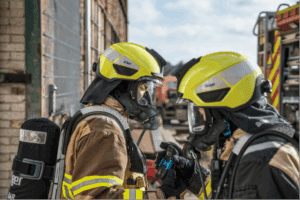The necessities of emergency lighting in evacuation: Emergency lighting plays a crucial role in fire safety for any building
When it comes to security advice, one of the most important areas has to be fire safety. This is because lives can be saved courtesy of the right guidance and fire security systems. So what is the importance of emergency and exit lighting in fire safety systems, where is it needed, and the what different types of lighting is available.
The Regulatory Reform (Fire Safety) Order 2005 makes anyone in charge of commercial premises and the common areas of a House in Multiple Occupation (HMO) responsible for the safety of everyone who works, visits or lives in the building. This duty of care includes the provision of emergency lighting.
The legal requirement is that non-domestic buildings must be safe at all times, including in the event that mains power failure occurs. For this reason, almost all such buildings must have emergency lighting fitted.
What is the purpose of emergency lighting?
Fire security systems need to incorporate emergency lighting because it can literally save lives. It is designed to make sure that in the event of the normal power supply failing, illumination is provided promptly, automatically and for sufficient time. This will ensure that occupants of a building are able to evacuate safely in the event of an emergency, such as a fire.
When a fire alarm sounds without warning, and fire starts to spread throughout a building, a sense of panic will often ensue. If the building is plunged into darkness, which is often the case during a fire, disorientation and confusion can arise, increasing the risk of injury, and making it all the more difficult for occupants to find their way out.
A clear escape route signalled by lights however, makes it more straightforward to exit the building safely during a fire.
Emergency escape lighting is designed to illuminate escape routes such as corridors and stairways, as well as the location of fire-fighting equipment such as fire extinguishers, together with security equipment such as key boxes that house emergency keys to exit doors.
What are the legal requirements for emergency lighting?
It is essential that any emergency lighting system is well-designed and adequately planned out in order to protect lives.
In legal terms, the light needs to stay on for one full hour following the main power outage. Where sleeping accommodation is concerned, for example in an HMO, this increases to three hours. By the time the lighting is able to turn off, all occupants of a building should have been evacuated safely.
What are the different types of emergency lighting?
There are various types of fire escape and exit lighting. The most traditional type consists of internal and external bulkhead emergency fittings which are connected to the main electrical wiring. These will usually operate for three hours without any mains power, for example when cables burn through, and will recharge when the mains power has been restored.
LED emergency lighting is becoming increasingly popular due to its energy saving advantages. Battery packs kick in automatically in the event of a power cut. Illuminated fire exit signs are another type of emergency lighting. These light up to show the location of fire exits.
Photoluminescent marker tape, paint and floor discs are also used to mark escape routes. They are especially useful where there are changes of level in a building, for example stairwells and uneven floors. These markings can be particularly effective when people need to escape through smoke, and for those who are partially-sighted.
What is the difference between maintained and non-maintained emergency lighting?
Maintained emergency light fittings can be operated with a switch. They can be left permanently on, or set to operate in the event of a power cut. Maintained lights are mostly used where groups of people meet, for example, in a cinema. They are designed to prevent total darkness, with the emergency lights able to function even in a power cut.
Non-maintained fittings will not illuminate unless there is a power cut. This type of emergency lighting is often powered by battery, which can charge itself through its own power supply. Any type of emergency lighting requires regular testing to ensure it meets current, relevant safety requirements.
Where is emergency escape lighting needed?
Each individual building will have its own particular requirements when it comes to emergency illumination. Even within a building, the needs will vary from one part to another. Some areas for example will benefit from natural light, whereas others will have a constant need for artificial light.
For buildings occupied during the night, emergency lighting will usually be required in all areas, including those that benefit from natural light during the day. Exceptions may be where ‘borrowed’ light from the likes of external street lamps will suffice, providing the light source is reliable, and the occupants of the building are familiar with its layout.
How is emergency lighting serviced and tested?
Organisations that fall under emergency lighting testing regulations need to follow a servicing schedule to ensure that it will perform correctly in the event of an emergency. BS EN 50172 / BS 5266-8 discuss the minimum levels of testing provisions, depending on the type of site you operate. Businesses need to appoint a “responsible person” to oversee the schedule.
Organisations can conduct either manual or automatic tests. Manual tests involve physically cutting off the power supply to see whether systems operate as intended. Automatic testing involves the use of self-testing emergency lightning, a special variety that will tell you if there’s a problem.
How often is it serviced and tested?
Testing falls into three categories.
Daily: Perform a visual inspection of central power supply indicators to ensure the system is operational (only applies to central battery systems).
Monthly: BS EN 50172 / BS 5266-8 dictate that organisations must test all emergency lighting systems monthly. Emergency lighting signage regulations require all luminaries and signs to illuminate and be clean and present. The monthly test will be a quick ‘flick’ test just to ensure that the emergency lighting switches on correctly.
Annually: Annual tests need to check that lights remain on for the test duration recommended by the relevant British Standard. All lights need to continue functioning correctly at the end of the test. Those that don’t require replacement.
The challenges
A report from Hilclare found that 44% of English firms ‘don’t have the correct’ emergency lighting, with prison sentences ‘a real consequence of poor emergency lighting practice’.
Eaton shared the 2020 report, which found that 44% of English firms ‘don’t have the correct emergency lighting’, as well as noting a 2018 report that revealed ‘over a third’ of the country’s social housing tower blocks have ‘inadequate’ emergency lighting’. A survey of 1,584 blocks found – 40% of the country’s entire social housing stock – saw 402 blocks, or 25%, admit there were ‘missing or broken’ emergency lighting on resident escape routes.
Eaton warned that prison sentences ‘are a real consequence’ of ‘poor emergency lighting practice’, with fines ‘growing in their severity’, and it shared discussion on the topic between its field product manager for lighting Anthony Martindale and fire safety consultant Chris Watts, who is also chairman of the British Standard committee responsible for BS 5266-1: 2016 Emergency lighting. Code of practice for the emergency lighting of premises.
The company also shared that between 2006 and 2009, defendants in legal cases relating to fire safety breaches were convicted of 1,904 charges, with 443 or 23% of these relating to article 14 of the Regulatory Reform (Fire Safety) Order 2005 [FSO], which covers emergency routes and exits. Additionally, multiple occupancy premises represented 17.5% of the national cases prosecuted, with article 14 ‘the most enforced’ article within the FSO.
Among high profile cases involving emergency lighting were the prosecution of the owner of the New Kimberley Hotel in Blackpool in 2015, with the owner given an 18 month prison sentence for breaching the FSO and ‘no proper emergency lighting cited as one of the breaches’. A Cardiff care home operator was also fined £400,000 in 2020 due to breaches including ‘deficient’ emergency lighting, alongside a Lincoln landlord fined the same amount in 2018 over lighting in their property.
Until that short-term mindset evolves into a longer term view which prioritises safety and considers total cost of ownership rather just the initial price tag, we will continue to see substandard equipment installed, a lack of appropriate maintenance and, sadly, peoples’ lives needlessly put at risk.
Michael Shulman, Principal Engineer, Lighting, UL
As we enter a new decade, lighting technology is moving ever further from its 20th century legacy. It now includes sensors for data acquisition, firmware and software for data analysis, wired and wireless controls for real-time lighting adaptation, and high-density batteries for operational continuity when the normal power system fails. Power over Ethernet (PoE) systems that integrate many of these developments are being deployed into smart buildings, which are likely to also include photovoltaic (PV) modules, energy storage systems (ESS), DC microgrids to optimize facility energy use and occupant comfort and productivity, and high capacity internet connectivity that must maintain data and power security.
These frontier-breaking developments are converging in the arena of emergency lighting systems. The regulatory system for emergency lighting is supported by the Life Safety Code (NFPA 101), the National Electrical Code (NEC) Article 700, and UL 924, the Standard for Emergency Lighting Equipment. The shared goal of these documents is to permit product installations that provide needed and desired functionality while precluding those that present excess risk to people and property. Emergency lighting is responsible for illuminating (with luminaires) and marking (with exit signs) the pathways for occupants to leave a building that requires evacuation during a power outage or other emergency. Above and beyond the fire- and electric shock-hazard evaluation to which all luminaires are subject, emergency lighting equipment must also demonstrate that it will function as intended.
Modern facility emergency lighting systems can include separate and remotely installed devices that must effectively communicate with one another in order for the system to operate properly. Legacy systems included automatic load control relays (ALCRs) to override off or dimmed settings of designated emergency luminaires; modern systems have added a variety of sensors and emergency lighting control devices (ELCDs), communicating through wired systems (including PoE) and wirelessly, to allow the system to more precisely respond to real-time building conditions and deploy emergency power when and where needed.
Shawn Mahoney, P.E. Engineer – Technical Services at NFPA
Emergency lighting for buildings is provided in two primary ways. One is to provide the building with an emergency generator and automatic transfer switch that will power a portion of the building’s lights upon loss of power. If that is the case in your building, the ITM performed on the generator must be completed per NFPA 110. The second method consists of providing separate emergency lighting units within the building that connect to the building’s power in order to charge the units’ batteries. Upon loss of power to the unit, the on-board battery then powers the emergency lights. In the case of these separate units, we need to perform ITM to ensure that the batteries are holding a charge, that the bulbs work, and the charge held can operate the lights for the required 90 minutes.
There are three techniques that can be used to ensure that the emergency lighting is operational: manual, self-test, and computer-based. Using the manual method, the emergency lights are operated monthly for at least 30 seconds by utilizing the manufacturer’s procedure—typically a test button that disconnects the main power to the unit—to ensure that the battery is holding more than a residual charge and to ensure that the lights are working. The emergency lights need to be operated on an annual basis for a minimum of 90 minutes to test the full capacity of the batteries.
In the self-test method, the units can test themselves and indicate an issue on the unit via an indicator light. These units do not need to be manually tested monthly or annually, but they need to be inspected every 30 days to make sure they are not damaged and that no indicator lights are on. In the computer-based method, a visual inspection is not required every 30 days, since any issues with the lights encountered during their self tests will be reported and logged via a computer.
To stay up to date on the latest, trends, innovations, people news and company updates within the global fire market please register to receive our newsletter here.
Media contact
Rebecca Morpeth Spayne,
Editor, International Fire Buyer
Tel: +44 (0) 1622 823 922
Email: [email protected]




































